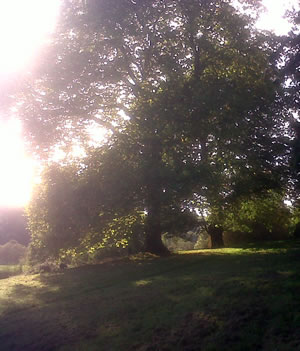‘… the rarest of all things, true genius’. (Walter Shaw Sparrow, art critic, 1926)
 Illustration: ‘The Lawns, Warham’ photographed today and painted by Brian Hatton in 1908
Illustration: ‘The Lawns, Warham’ photographed today and painted by Brian Hatton in 1908
Many of you will recognise these trees (illus.) on your right as you walk down the public footpath towards the River Wye from Warham Lane to Warham Steps. If you turn left and up along Warham Lane you will pass Warham Court, and if you travel down to the river from the farm you will reach Hopyard Meadow, opposite Belmont Woods and the beginnings of the golf club to your right.
You may not know that these landscapes were the subjects of paintings by Brian Hatton (1887 – 1916), a member of the Hatton family who lived at Broomy Hill. He had scarcely begun to talk before taking up pencil and paper. He displayed an extraordinary gift for drawing. His parents, particularly his mother, dedicated themselves to nurturing this talent, seeking out the best teachers and offering his works for exhibitions.
Brian earned his first Royal Drawing Society Gold Star, in 1898, when he was only eleven years old. It was awarded for one of his studies of working horses. His talent was recognised by the renowned artist, G. F. Watts, who, along with his wife, Mary, became his guide and mentor. As a teenager, Brian spent hours at Warham Court watching the rhythm of farming life and using it as subject matter for sketching and painting; he walked or rode through the lanes of Breinton, choosing to paint farms such as Upper Hill, and capturing scenes of hard labour and toil with great emotional feeling.
At the outbreak of the First World War Brian Hatton joined the Worcestershire Yeomanry, a cavalry regiment. In November 1914 he married Lydia Bidmead, a dancer from Hereford. His daughter, Mary Amelia, was born in September 1915, shortly before he was posted to Egypt. On Easter Sunday, 23rd April 1916, he was killed in action in Qatia, Egypt, aged 28.
Brian Hatton left over a thousand drawings and paintings, many of which can be seen in the Hereford Museum Resource and Learning Centre. Before his tragically early death, he had begun to acquire a reputation as a portrait painter, but his love of the countryside around Breinton and Warham, and his attachment to the rural life resonates in much of the work he left behind for everyone to enjoy. Just as we can see the preserved Suffolk landscape at Flatford Mill and Dedham Vale today and relate it to scenes captured by Constable, so we can still compare the unchanged Hereford landscape today with scenes painted over a hundred years ago by Brian Hatton. If the inner western ‘relief” road is built over the river, the very lane between Warham Court and Warham House will be severed, and the magnificent views of the Wye valley, painted by Brian Hatton, will be irreparably damaged.



